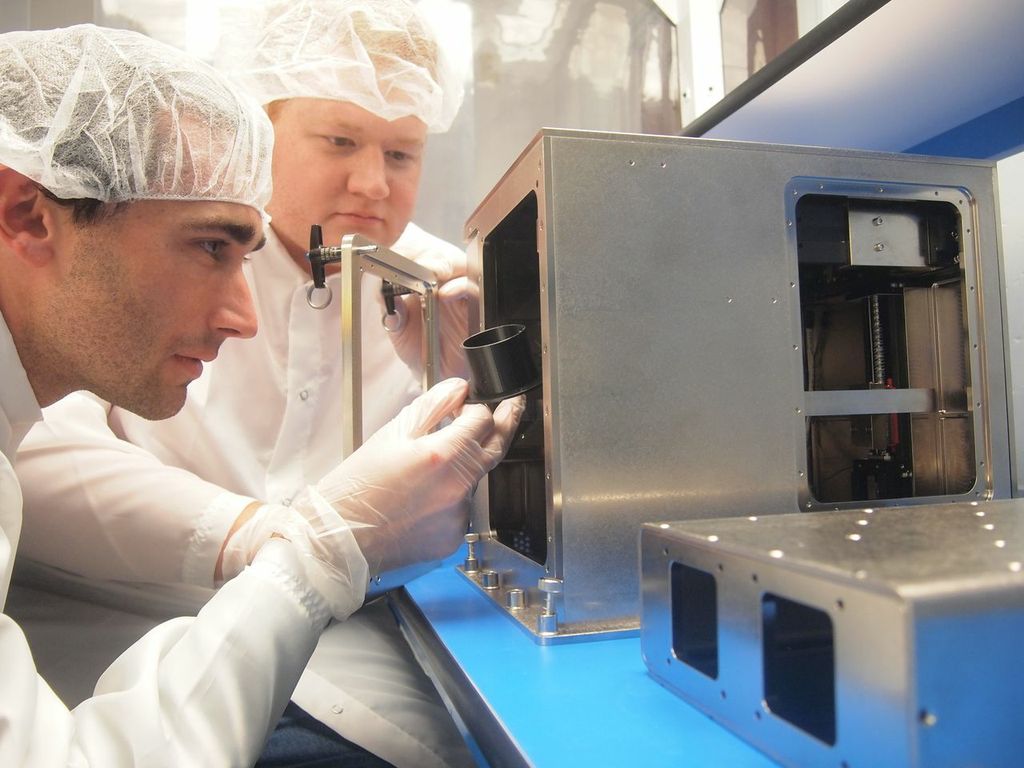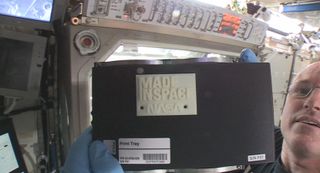
Welcoming the Era of In-Space Manufacturing

Mike Snyder, lead engineer for the company Made In Space, which designed and built the 3D printer currently aboard the International Space Station, contributed this article to Space.com's Expert Voices: Op-Ed & Insights.
Human spaceflight reached an important milestone this week. An additive manufacturing device, or 3D printer, was turned on, and initiated the first official 3D print on the International Space Station (ISS).
The print took slightly more than an hour, and once it finished, the world changed. At the Made In Space Operations Center in Moffett Field, California, the rest of the team and I had the ability to command the printer and see inside it as the machine received and executed our commands. For the first time, humans demonstrated the ability to manufacture while in space. At this moment, if the space station absolutely needs a part that the 3D printer can build, I can start producing the part onboard the ISS within minutes — from my chair in California.

The ability to deliver components on demand without the need of a launch vehicle can redefine how space-mission strategies work. Before last week, every object that humans have ever put in space was launched there and not made in space. Of course, many experiments and efforts have been able to form items such as crystalline structures and latex spheres, as well as assembly-type construction. 3D printing is completely different. This capability does more than just build predetermined articles that were designed months or years before launch. The 3D printer can build files that are created after launch and sent to orbit when needed. [3D Printing: 10 Ways It Could Transform Space Travel]
Our printer is part of the NASA-funded 3D Printing in Zero-G Technology Demonstration, which is setting out to characterize the performance and demonstrate the functions of additive manufacturing in orbit. The experiment will also help troubleshoot potential problems for future facilities now under development, mainly the Additive Manufacturing Facility (AMF), which launches next year and offers commercial services. While the AMF will be a more advanced and a longer-term device, the 3D printer that currently resides on the space station is a great stepping stone to the future.
The space station's printer will use common consumer plastics, which limits its applications. But the printer's arrival still means that a set of components will never have to be launched again. The AMF will increase the number of such components, and future facilities will keep increasing the capabilities, to a point where the only items necessary to be launched into space are the astronauts themselves.
This future of space manufacturing may be distant, and will undoubtedly take an extremely large amount of effort and work to accomplish, but it is achievable.
Get the Space.com Newsletter
Breaking space news, the latest updates on rocket launches, skywatching events and more!
It is often difficult to see the importance of the first steps to something that eventually solves larger problems. A groundbreaking endeavor requires an extreme amount of understanding and trust at the outset. Even just 30 years ago, one would be hard-pressed to find anyone who believed that a device that can fit inside your pants' pocket could contain a phone, messaging service, calendar, computer and GPS receiver. However, there were people whose actions and drive made that a reality.
Similarly, it will be hard to convince everyone that a machine the size of a microwave has the ability to produce most of the parts of a spacecraft in the future. Some of the technologies that such a machine will need have not been invented yet, and others are at low-maturity level. This idea tends to be difficult for me to digest myself; however, the benefit of such a device would revolutionize how future exploration missions are realized. [Visions of the Future of Human Spaceflight]
Space-based manufacturing will also provide innumerable advances to the logistics and manufacturing of products on Earth. It is impossible to determine all of the benefits to Earth that a future digital manufacturing device may hold. Products will be available at your fingertips, similar to how Internet stores function now. The key difference is that shipping will not be needed; the product will just materialize using raw materials and a manufacturing system. This will reduce the amount of transportation associated with the supply chain, reducing the cost of products and eliminating the pollution generated by ships, trucks, and trains.
These are just two examples of the benefits that can come from 3D-printing technologies. There could be many more that are even more beneficial. Henry Ford's obvious goal when he started mass-producing automobiles was to lower the price to create high demand. Any history book will tell you he was highly successful. An omission in that story is how his efforts also made urban environments more sanitary. The automobile replaced the horse, whose presence required stables, which had to manage the urine and fecal waste from the horses. When the animals were largely eliminated from transportation use, that requirement faded away.
Clearly automobiles exchanged one environmental concern with another, but automobile waste does not tend to facilitate biological agents that cause disease and sickness to be passed and multiply. You can never truly know how a technology will affect its surroundings in totality, which is the most exciting part of working with any newly developing technology. Even the current 3D printer on ISS will most likely surprise people, as I believe the most advantageous uses have yet to be conceived.
The future is going to be very exciting for manufacturing in space, with significant developments coming as soon as next year. New technologies are currently being developed in order to alleviate the need to launch the feedstock, for example. Progress develops along interesting paths, many of them unintentional. The availability of an in-space manufacturing platform will provide a multitude of new possibilities, and I cannot wait to see what results.
Follow Mike Snyder on Twitter @spacesnyder. Follow all of the Expert Voices issues and debates — and become part of the discussion — on Facebook, Twitter and Google+. The views expressed are those of the author and do not necessarily reflect the views of the publisher. This version of the article was originally published on Space.com.
Join our Space Forums to keep talking space on the latest missions, night sky and more! And if you have a news tip, correction or comment, let us know at: community@space.com.










